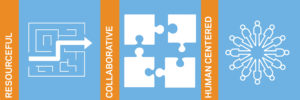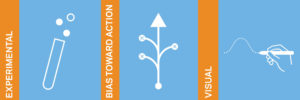Breaking Down Design Thinking
Four Processes of Design: Explore, Reframe, Generate, Prototype
1. Human-centered design is built around the process of developing empathy for your users, the community for which you are creating a solution. The explore phase encourages designers to get out of the building and talk to users, learning about their lives, their emotions, and their needs. By the end of your exploration, you will have seen the world through your users’ eyes and developed insights towards a solution that fits their needs.

2. Initial assumptions are generally never completely correct. After gaining deep user insights, it’s time to come back and reframe what you’ve learned about the community you’re designing for. By better understanding the information you’ve gleaned, you can start to see where your ideas and solutions can fit into the bigger picture.
3. Creativity plays a role in everything from a successful startup idea to a successful morning routine. The generate phase of design thinking takes user insights and needs and turns them into innovative solutions. Through ideation and generation, entrepreneurs are pushed to think outside the box, reach beyond their initial assumptions, and approach problem solving in a clearer way.

4. A good idea deserves to be tested. During the prototype phase, entrepreneurs develop an early version of their solution to test their assumptions and gain deeper insights with customers. The best solutions are iterated based on a continuous feedback loop with users; great entrepreneurs have a bias towards action as a way to learn quickly and avoid massive failures.
5 Human Behaviors to Unleash Your Creativity:
Be resourceful: Every moment is an opportunity to learn. Resourceful process designers are scrappy, finding creative solutions to constrained situations. We encourage you to rethink the skills and resources you have, and to see challenges as an opportunity for more a creative solution.
Embrace your Team: We firmly believe that you can do more with others than you can do alone. Teamwork and collaboration ensure more diverse points of view and spark more creative outcomes. Share your idea constantly, and be ready to adapt and improve from the feedback you receive.

Be Human-Centered: In design, the user is always at the center of the process. From generating creative ideas to building and testing prototypes, keeping the user at the center ensures a solution is never too far off base. A savvy designer will never waste money on a solution that will never be used.
Think Visually: A picture is worth a thousand words; in the same vein, a designer is more likely to draw their idea than talk about it. With visual tools like sketching or building, a good designer can always show their user what their idea is.

Experiment Constantly: Embrace experimentation as a path to quickly improve. A designer sees each step of the design process as an opportunity to test their assumptions and confirm (or deny) their initial ideas. This constant iteration is the key to quickly and confidently developing a great idea.

